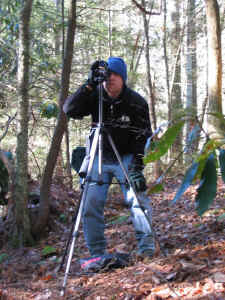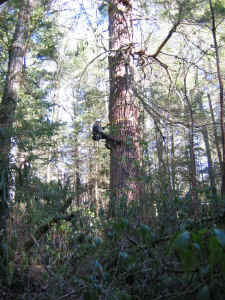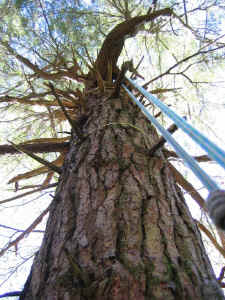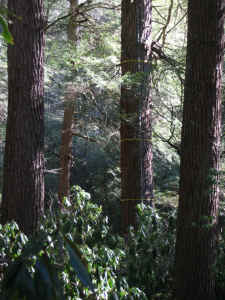ENTS,
Several posts in the last few weeks have mentioned the use of a
monocular
reticle for determining remote widths, as in tree trunks. Jess
introduced
the device in his recent report on the giant tuliptree in Cosby,
TN. We
wanted to take some time to fully discuss this instrument and
the
implications for its use.
 Jess using Reticle
Jess using Reticle
Jess's father, long-time ENTS member Doug Riddle, is an
electrical engineer
(who is particularly fond of gadgets) and has used his monocular
reticled
macroscope (hereafter reticle) to check specifications of
installed
components that could not be reached. His is a model made by
PENTAX that is
an 8X30 monocular with a field of view of 6.2 degrees. It has an
internal
scale (reticle) that can be optically transposed across an
object. The scale
runs from 0-4 (mm) with ten graduations between each number.
This gives an
effective resolution of 40 increments. The "zero"
(left hand of scale) is
demarcated by a long vertical line that is useful for
"averaging" the bark
or trunk profile. We found that the extreme sharpness and
clarity of the
scale easily allows optical divisions of each gradation into
10ths (as we do
with clinometers). In our tests Jess and I often estimated to
the same
1/10th gradation. On sharply defined objects 1/100th estimations
are
entirely possible making the scale extremely accurate. The
gradations are
then multiplied by the distance and a factor to get the actual
width of the
target.
 macroscope25
macroscope25
Our intended use for the instrument was to see if it could be
used in
determining diameter of tree trunks aloft to help measure
displacement
volume. Bob Leverett has been extensively testing the RD1000 for
such
applications and has found a myriad of inherent limitations. The
reticle is
extremely simple and fits right in with our existing instruments
(laser and
clinometer) for a low-budget three dimensional measuring outfit.
The catch
is- is it accurate enough?
To assess its applications into tree volume modeling Jess and I
devised a
series of tests to ascertain the range of use and accuracy. We
ran
duplicates (Jess and I independently) of the following tests:
Width of trees and flat objects
Same tree trunk at various distances,
Window sill at various distances,
Tree trunk; four locations up trunk, each at the four cardinal
directions.
Fixed round objects
Steel billboard post; diameter at various distances,
Steel billboard post; volume,
Steel billboard post; volume- laser versus taped baseline.
And finally, the ultimate test;
Tree climb; diameters and volume versus climb data.
Rather than go into detail of each test and lose everyone on the
list I will
summarize the findings of each test. But I'll tell you know we
have stumbled
upon a revolution in volume modeling. The device tested well
above our
expectations. Accuracy does not diminish with distance and is
not restricted
to distance or scale size like the RD1000 (it also costs much
less). It does
not use batteries and is very easy to carry.
Here are the results of the above tests.
Width of trees and flat objects
Same tree trunk at various distances
Target: white oak measured diameter (w/ tape) at 1.007 feet.
Maximum
error was 5.8 % while working at 30 feet. After getting into the
working
range of the device (45'+) error dropped to less than 2.5% (.3
inch).
Average diameter over a range of 30 feet to 165' was 1.007 for
Will and .999
feet for Jess. Widths were slightly overstated at long distances
and
slightly under at close distances. Jess and I differed by
slightly over 1%
in our reticle readings. This was the first time either of us
had used it.
But, trees are not round and thus the diameter of 1.007' was a
calculation,
not an actual width. So the next test was of a flat object with
no curves.
Window sill at various distances
Target: a white window sill taped at 73.5 inches wide. We
measured it from
125-200 feet away at 15 foot intervals. Will averaged 73.49
inches and Jess
73.52 inches. Maximum error was .15 inches over for Will and
.375 inches
under for Jess.
 Jess and flagged trunk
Jess and flagged trunk
Tree trunk; four locations up trunk, each at four cardinal
directions.
Target: a relatively straight tuliptree measured from four
locations, 90 degrees different from each other. Four locations
from the
base to over 20'were marked with yellow flagging tape
perpendicular to the
trunk. The girth of each point was measured with a tape. Each
flagged point
was then measured with the reticle from four directions paired
from opposite
sides (same baseline distance). Jess and I independently
measured each
point. The maximum difference in reticle scale reading between
our
measurements was a miniscule 0.015 of a gradation so I will
combine our
results. Since volume determination is based on girths (obtained
to convert
to diameter) I will summarize the results in girth. I will point
out that
parts of the trunk were elliptical with a maximum linear
difference (width)
between 90 degree measurements being over 5.6 inches (23.34
inches one way
and 17.4 in the other). The measurements obtained at opposing
positions were
nearly identical with a maximum difference of just 0.049 feet
(.59 inch)
which was incidentally obtained on a "shot" through
brush. Here are the
results:
Trunk point Reticle girth Taped girth Elliptical offset
20.08' 58.81" 61" 3.2"
14.58' 63.16" 64.625" 5.6"
6.58' 66.21" 66.375" 1.92"
Base 77.04" 77.5" 1.8"
I suspect the volume calculated from the two opposing reticle
values (an
ellipse) would more accurately represent the actual volume since
the tree is
not round. Taped girths would tend to overestimate the volume.
However,
later field tests may show otherwise (see below).
Fixed round objects
Target: steel billboard post; diameter at various distances
The post was taped to 3.01 feet in diameter and assumed to be
round.
Reticle indicated a diameter of 3.02 feet with a maximum error
of 3.06 feet
(+1.3%). We measured at distances of over 280 feet.
Steel billboard post; volume
Using the rangefinder and clinometer we measured the height of
the
post and various points along the length with the reticle to
determine
volume. Girths used in the calculations were on the average .05
feet off (.6
inches circumference) which yielded a volume of 456.65 ft3 over
a length of
63.2 feet. Actual volume based on the taped girth and baseline
was 459.88
ft3, indicating an understatement of .7% or 3.23 ft3.
Steel billboard post; volume-laser versus taped baseline
Interestingly, the taped baseline with reticle girths overstated
the
volume by 4.1%. We are baffled by this and suspect human error.
And finally, the ultimate test.
Tree climb; diameters and volume versus climb data.

Will setting the flagging |

Tapes set |
Jess and I selected a huge hemlock tree with easy access and
visibility to
test the reticle against a tree climb. I climbed the tree and
set up five
marked intervals like in the tuliptree above. I wrapped yellow
flagging tape
around the trunk and measured the girths at that point. We then
set up the
reticle in two locations roughly 90 degrees from each other so
we could get
the widths at each point and determine the elliptical numbers.
We then
calculated the volume of the marked section using the climb data
and the
reticle data. We were impressed!

Trunk fro first Position |

Trunk with flagging |
I'll cut to the chase. For the 47.5 foot long modeled section
the climb data
indicated a displacement volume of 535.74 ft3. The reticle data
collected by
Will indicated a volume of 529.7 ft3 and for Jess, 526.32 ft3.
The
difference was 9.42 ft3 at the most, an impressive difference of
only 1.8%!
These numbers were from a taped baseline to the middle of the
trunk with no
lean taken into account (very minor). The laser distances were
somewhat
longer indicating a long reading that must be calibrated. As
such, the laser
(uncorrected) estimated the volume as 562.99 ft3 for Will and
559.34 ft3 for
Jess. Still, the results were within 5.1% of the climb data. One
of the
numbers for the lasered hypotenuse distance was erratic and
added nearly 1.8
feet to the length of a large section which added about 22 ft3.
Correcting
this section alone would reduce the "error" to a 4.3
ft3 overestimate or
less than 1% off.
Obviously, the more we use it and refine our techniques and
learn the
nuances of the equipment we should be able to obtain remote
volume
estimations within 95-99% of a climb. Jess and I were hoping for
95%
accuracy and with a bit more practice should be able to obtain
that goal
consistently.
I am not sure that further testing of the reticle is needed but
a visit to
trees that have already been climbed and measured could prove
useful.
Comparing a random series of shots at various locations to
calculate volume
and compare it to the climbed results could give insight into
how many shots
are needed and where. The problem is we never really know the
absolute
volume. To us, the reticle seems to be the best option other
than climbing.
Jess and I have already begun to model hemlocks and Jess has
measured two
big tuliptrees for main trunk volume. We intend to use the
reticle
extensively in Congaree next month; loblolly pine and cherrybark
oak are on
the menu.
Where can you get one?
Jess and I searched with no luck for the Pentax model. It is no
longer
manufactured. We did find some through a company named Cole-Parmer
Instruments in Illinois and I ordered one. I also ordered one
from Ben
Meadows Company (1-800-241-6401) which has miraculously just
appeared in
their new 2006 catalog. The biggest issue with all the models is
close
focus, as the reticle scale will go out of focus at close
distances. The
units, when used as telescopes, have the reticle in focus when
set at
infinity. The unit from Cole-Parmer (made by Specwell) has its
focus set at
over 300 feet- not useful for ENTS. Although a camera repair
shop believes
the focus can be reset I returned the Specwell units in favor of
the Ben
Meadows model which arrived this week. The Ben Meadows model
(catalog #
6JB-221152, page 573) has the advantage of a wider field of view
than the
Pentax (hence more gradations; 0-50) and a scale that starts at
0 on the
left (the Specwell model had "0" in the center- very
awkward). It is also
$70 cheaper! The focus is good as set so it can be used
instantly. I did
retain the tripod adapter (a fancy clamp) from Cole-Parmer to
attach it
securely to the tripod (Item # WD-03099-62 on website). However,
simple
attachments can be made with wood and straps.
To check its accuracy Jess and I have put the "new"
model through some
tests. The first test (diameter of a steel light pole) sucked.
We made a
mistake of not visiting the pole first- it was not round! We
also determined
that the factor supplied with the instrument was significantly
incorrect. It
may have been a relic manual from previous model that was not
updated for
this model. In any case, Jess' math prowess solved the problem
and the new
factor revealed excellent results in the next test of a 5' wide
board.
Widths were no more than .26 inch off over distances from
100-200 feet away.
The average error was .0765 inch. Looks like it will work just
fine!
Field observations and techniques
The narrow field of view in Doug's PENTAX model (6.2 degrees)
necessitates
being rather far back from large trees. So in our search for a
suitable
model for our regular use we looked for one with a wider field
of view. The
first model we ordered (Specwell) had a field of view of 8.2
degrees- vastly
more useful for large trees at close distances. The scale could
span a six
foot wide object at 95'. However, as mentioned above, we soon
found the
unit's focus with regard to the reticle set way to far away.
This makes
sense for its use as a telescope but the reticle scale was sharp
only at
over 300 feet away. Focusing in on closer objects would
eliminate the scale
from view. Not good. The Ben Meadows model has a wider field of
view than
Doug's but not as wide as the Specwell model. I am not sure of
the
specifications but it is substantially wider. Being able to work
within a
reasonable range is helpful since the farther you have to move
back the more
obstacles position themselves between you and the tree.
Another crucial component of the ultimate accuracy of this
technique is
getting an accurate distance to the tree. We have come to
realize that
estimating to 1/10th yards is entirely reasonable by finding
click-over and
checking against the eyepiece of the reticle, which is
stationary. This
means that a properly calibrated laser will be highly accurate
for distances
even at +/- 1 yard resolution. When modeling, we measure to the
midpoint of
the trunk. All points are referenced to a common base target
which is
usually a tape or flagging wrapped around the tree. All
measurements from
any location can then be easily referenced against each other.
Heights of
the aerial targets are measured by placing the clinometer on or
next to the
reticle and using the distance to the nearest 1/10th yard. We
also measure
the taped reference point to compare the actual girth to the
reticle
estimation. We have found that they are often just an inch or
two different.
Some limitations which we find to be rather minor are that you
MUST use a
tripod (and not in the wind!). The reticle is so precise that a
slight shift
will throw off the measurements. Even standing on the adjacent
duff layer
can shift the tripod! We are using a tripod made by Samsonite
($50 at
Circuit City) that has a functional height of 66"- good for
the neck! You
also need a vantage point with a view of as much of the tree as
possible.
This can take some time to find, but once the reticle is set up
many
measurements can be made from one side. These points can then be
compared to
another set-up and if a common reference be found, elliptical
sections can
be used for volume calculations.
Jess and I have successfully used the reticle in hemlock forests
in low
light conditions, but the reticle can be hard to see if it is
dark in the
background. Also, laser distances can be hard to obtain through
the
branches. As such you are limited to portions of the trunk that
can both be
seen with the reticle and hit by the laser. We have not found
this to be a
huge issue, mainly because there is not much volume in the upper
canopy
portion (of conifers) and more measurements will not gain but a
miniscule
increase in accuracy.
So, there it is formally introduced. Nowadays the device is not
left at home
when we go into the woods. It has become a standard part of our
gear
arsenal. More significantly though is how it has changed the way
we look at
trees. With more and more experience in modeling we can now
ascertain the
relationships of tree growth (volume) within and between
species. We intend
to begin determining annual volume accrual by accurately
measuring the
displacement volume and coring the tree for age. Questions start
to present
themselves; at what age and on what sites do tuliptrees grow the
fastest?
How much wood can they grow in a year? Where do they put down
the most wood?
Do they slow down or increase wood production over time? If so,
by how much?
Could they grow faster when they are big? What about white pine?
.Oh no, Bob
Leverett will have an aneurysm.
Now it appears that we have the tools to answer these questions.
Will Blozan and Jess Riddle
|